2019 MASERATI LEVANTE lock
[x] Cancel search: lockPage 45 of 436
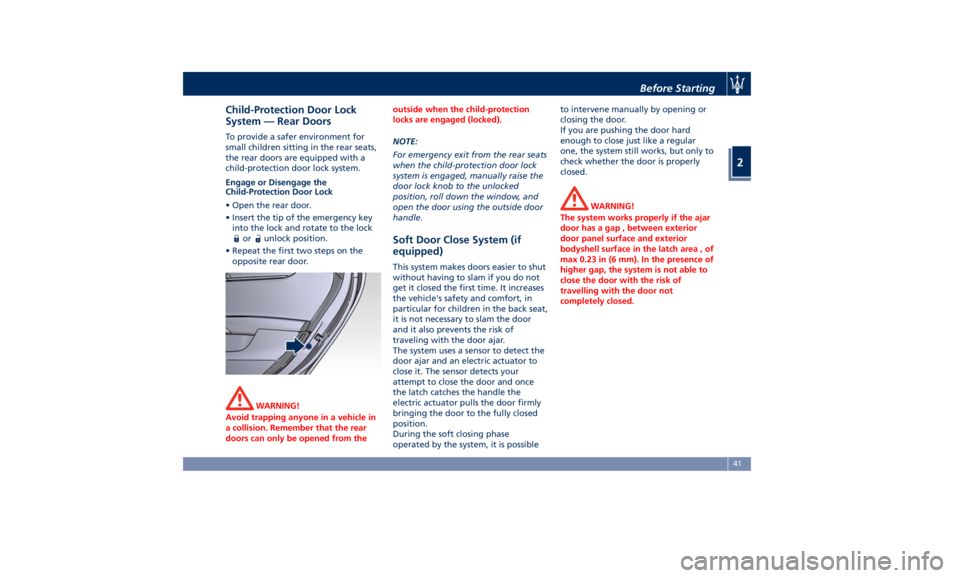
Child-Protection Door Lock
System — Rear Doors To provide a safer environment for
small children sitting in the rear seats,
the rear doors are equipped with a
child-protection door lock system.
Engage or Disengage the
Child-Protection Door Lock
• Open the rear door.
• Insert the tip of the emergency key
into the lock and rotate to the lock
or unlock position.
• Repeat the first two steps on the
opposite rear door.
WARNING!
Avoid trapping anyone in a vehicle in
a collision. Remember that the rear
doors can only be opened from the outside when the child-protection
locks are engaged (locked).
NOTE:
For
emergency exit from the rear seats
when the child-protection door lock
system is engaged, manually raise the
door lock knob to the unlocked
position, roll down the window, and
open the door using the outside door
handle.
Soft Door Close System (if
equipped) This system makes doors easier to shut
without having to slam if you do not
get it closed the first time. It increases
the vehicle's safety and comfort, in
particular for children in the back seat,
it is not necessary to slam the door
and it also prevents the risk of
traveling with the door ajar.
The system uses a sensor to detect the
door ajar and an electric actuator to
close it. The sensor detects your
attempt to close the door and once
the latch catches the handle the
electric actuator pulls the door firmly
bringing the door to the fully closed
position.
During the soft closing phase
operated by the system, it is possible to intervene manually by opening or
closing the door.
If you are pushing the door hard
enough to close just like a regular
one, the system still works, but only to
check whether the door is properly
closed.
WARNING!
The system works properly if the ajar
door has a gap , between exterior
door panel surface and exterior
bodyshell surface in the latch area , of
max 0.23 in (6 mm). In the presence of
higher gap, the system is not able to
close the door with the risk of
travelling with the door not
completely closed.Before Starting
2
41
Page 46 of 436
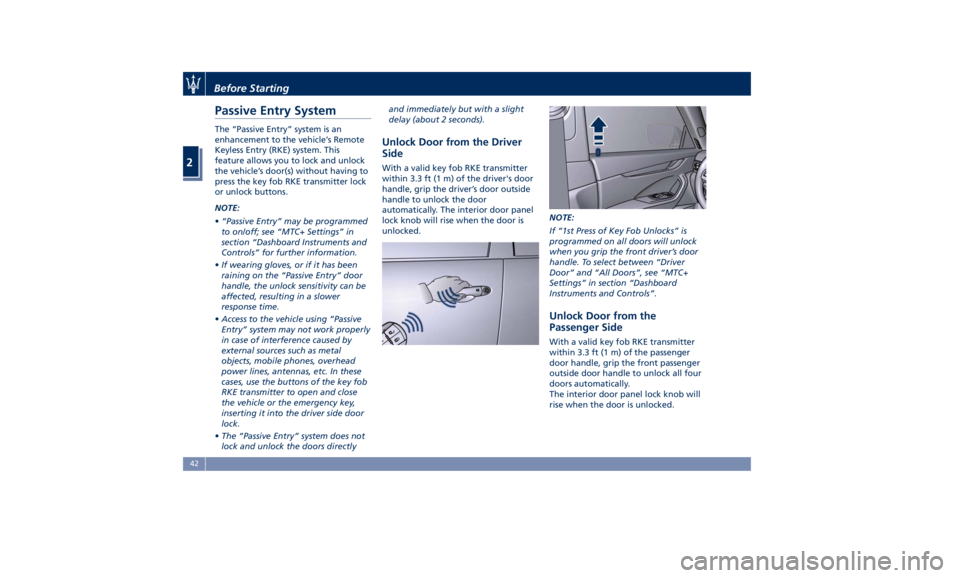
Passive Entry System The “Passive Entry” system is an
enhancement to the vehicle’s Remote
Keyless Entry (RKE) system. This
feature allows you to lock and unlock
the vehicle’s door(s) without having to
press the key fob RKE transmitter lock
or unlock buttons.
NOTE:
• “Passive Entry” may be programmed
to on/off; see “MTC+ Settings” in
section “Dashboard Instruments and
Controls” for further information.
• If wearing gloves, or if it has been
raining on the “Passive Entry” door
handle, the unlock sensitivity can be
affected, resulting in a slower
response time.
• Access to the vehicle using “Passive
Entry” system may not work properly
in case of interference caused by
external sources such as metal
objects, mobile phones, overhead
power lines, antennas, etc. In these
cases, use the buttons of the key fob
RKE transmitter to open and close
the vehicle or the emergency key,
inserting it into the driver side door
lock.
• The “Passive Entry” system does not
lock and unlock the doors directly and immediately but with a slight
delay (about 2 seconds).
Unlock Door from the Driver
Side With a valid key fob RKE transmitter
within 3.3 ft (1 m) of the driver's door
handle, grip the driver’s door outside
handle to unlock the door
automatically. The interior door panel
lock knob will rise when the door is
unlocked. NOTE:
If “1st Press of Key Fob Unlocks” is
programmed on all doors will unlock
when you grip the front driver’s door
handle. To select between “Driver
Door” and “All Doors”, see “MTC+
Settings” in section “Dashboard
Instruments and Controls”.
Unlock Door from the
Passenger Side With a valid key fob RKE transmitter
within 3.3 ft (1 m) of the passenger
door handle, grip the front passenger
outside door handle to unlock all four
doors automatically.
The interior door panel lock knob will
rise when the door is unlocked.Before Starting
2
42
Page 47 of 436
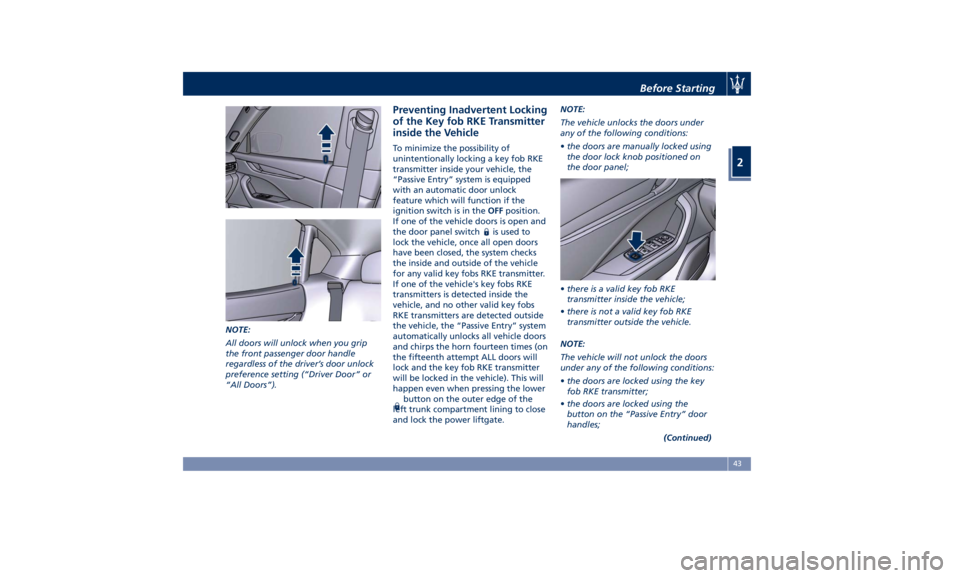
NOTE:
All doors will unlock when you grip
the front passenger door handle
regardless of the driver’s door unlock
preference setting (“Driver Door” or
“All Doors”). Preventing Inadvertent Locking
of the Key fob RKE Transmitter
inside the Vehicle To minimize the possibility of
unintentionally locking a key fob RKE
transmitter inside your vehicle, the
“Passive Entry” system is equipped
with an automatic door unlock
feature which will function if the
ignition switch is in the OFF position.
If one of the vehicle doors is open and
the door panel switch
is used to
lock the vehicle, once all open doors
have been closed, the system checks
the inside and outside of the vehicle
for any valid key fobs RKE transmitter.
If one of the vehicle's key fobs RKE
transmitters is detected inside the
vehicle, and no other valid key fobs
RKE transmitters are detected outside
the vehicle, the “Passive Entry” system
automatically unlocks all vehicle doors
and chirps the horn fourteen times (on
the fifteenth attempt ALL doors will
lock and the key fob RKE transmitter
will be locked in the vehicle). This will
happen even when pressing the lower
button on the outer edge of the
left trunk compartment lining to close
and lock the power liftgate. NOTE:
The vehicle unlocks the doors under
any of the following conditions:
• the doors are manually locked using
the door lock knob positioned on
the door panel;
• there is a valid key fob RKE
transmitter inside the vehicle;
• there is not a valid key fob RKE
transmitter outside the vehicle.
NOTE:
The vehicle will not unlock the doors
under any of the following conditions:
• the doors are locked using the key
fob RKE transmitter;
• the doors are locked using the
button on the “Passive Entry” door
handles;
(Continued)Before Starting
2
43
Page 48 of 436
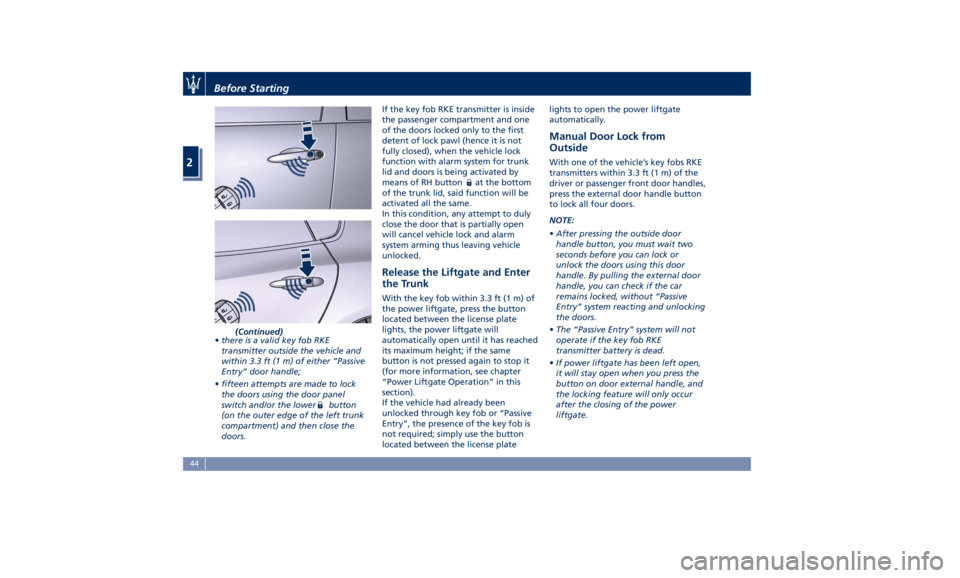
(Continued)
• there is a valid key fob RKE
transmitter outside the vehicle and
within 3.3 ft (1 m) of either “Passive
Entry” door handle;
• fifteen attempts are made to lock
the doors using the door panel
switch and/or the lower
button
(on the outer edge of the left trunk
compartment) and then close the
doors. If the key fob RKE transmitter is inside
the passenger compartment and one
of the doors locked only to the first
detent of lock pawl (hence it is not
fully closed), when the vehicle lock
function with alarm system for trunk
lid and doors is being activated by
means of RH button
at the bottom
of the trunk lid, said function will be
activated all the same.
In this condition, any attempt to duly
close the door that is partially open
will cancel vehicle lock and alarm
system arming thus leaving vehicle
unlocked.
Release the Liftgate and Enter
the Trunk With the key fob within 3.3 ft (1 m) of
the power liftgate, press the button
located between the license plate
lights, the power liftgate will
automatically open until it has reached
its maximum height; if the same
button is not pressed again to stop it
(for more information, see chapter
“Power Liftgate Operation” in this
section).
If the vehicle had already been
unlocked through key fob or “Passive
Entry”, the presence of the key fob is
not required; simply use the button
located between the license plate lights to open the power liftgate
automatically.
Manual Door Lock from
Outside With one of the vehicle’s key fobs RKE
transmitters within 3.3 ft (1 m) of the
driver or passenger front door handles,
press the external door handle button
to lock all four doors.
NOTE:
• After pressing the outside door
handle button, you must wait two
seconds before you can lock or
unlock the doors using this door
handle. By pulling the external door
handle, you can check if the car
remains locked, without “Passive
Entry” system reacting and unlocking
the doors.
• The “Passive Entry” system will not
operate if the key fob RKE
transmitter battery is dead.
• If power liftgate has been left open,
it will stay open when you press the
button on door external handle, and
the locking feature will only occur
after the closing of the power
liftgate.Before Starting
2
44
Page 49 of 436
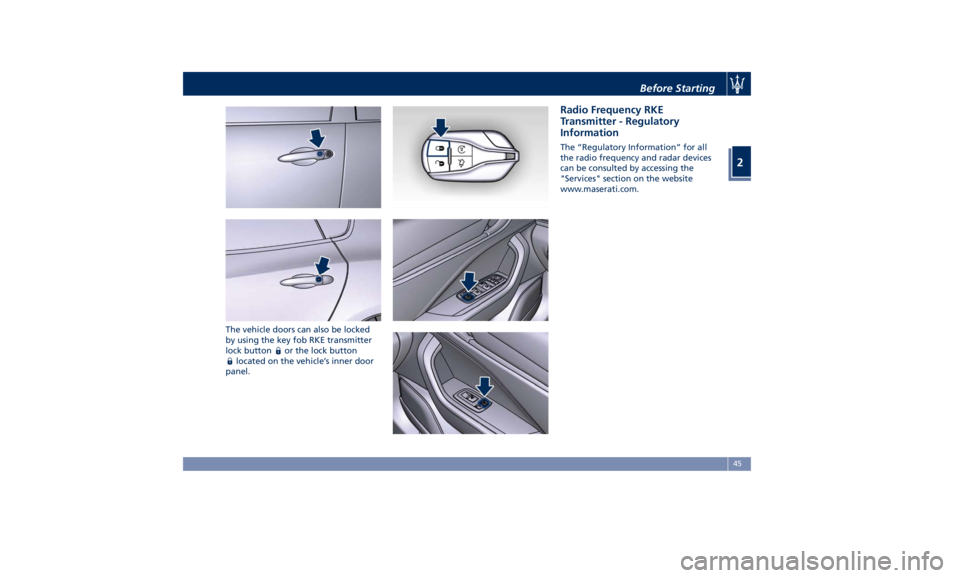
The vehicle doors can also be locked
by using the key fob RKE transmitter
lock button
or the lock button
located on the vehicle’s inner door
panel. Radio Frequency RKE
Transmitter - Regulatory
Information The “Regulatory Information” for all
the radio frequency and radar devices
can be consulted by accessing the
"Services" section on the website
www.maserati.com.Before Starting
2
45
Page 50 of 436

Power Windows The window controls on the driver's
door panel govern all the door
windows.
There are single window controls on
each passenger door trim panel, which
operate the corresponding window.
The window controls will operate only
when the ignition switch is in the ACC
or RUN position. NOTE:
• The power window switches will
remain active for up to 10 minutes
after the ignition switch is turned to
the OFF position. Opening either
front door will cancel this feature.
The time lapse can be set. See “MTC+
Settings” in section “Dashboard
Instruments and Controls” for
further information.
• Frequent activations of the power
windows could result in a temporary
lock out of the motors. In this case,
wait a moment before a new
activation.
WARNING!
Improper use of the power windows
and the sunroof (if equipped) can
however be dangerous, even with the
anti-pinch prevention system. Before
and during activation of the power
window, always check that the
passengers are not exposed to the risk
of injury both by the moving window
and by personal objects that could be
dragged or hit by it. Do not leave
unattended children in a vehicle with
a key fob RKE transmitter inside.
When getting out the vehicle, always
remove the key fob RKE transmitter to prevent the windows being
accidentally activated, posing a risk to
passengers remaining onboard.
Auto-Down Feature The driver door power window switch
and some model passenger door
power window switches have an
auto-down feature.
Press the window switch to the second
detent, release, and the window will
go completely down automatically.
To open the window part way, press
the window switch to the first detent
and release it when you want the
window to stop.
To stop the window from going all the
way down during the auto-down
operation, pull up on the switch
briefly.
Auto-Up Feature with
Anti-Pinch Protection Lift the window switch to the second
detent, release, and the window will
go all the way up automatically.
To stop the window from going all the
way up during the auto-up operation,
push down on the switch briefly.
To close the window part way, lift the
window switch to the first detent andBefore Starting
2
46
Page 51 of 436
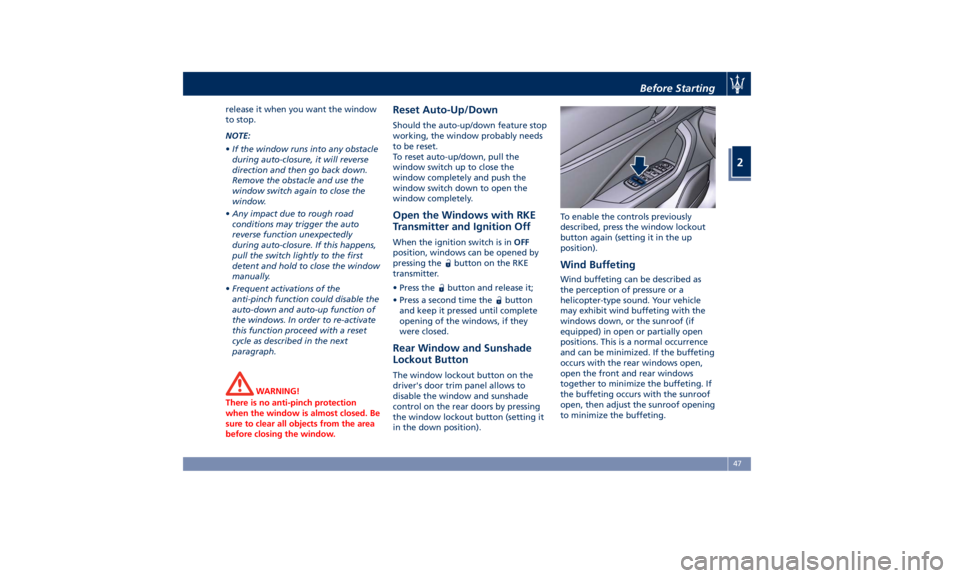
release it when you want the window
to stop.
NOTE:
• If the window runs into any obstacle
during auto-closure, it will reverse
direction and then go back down.
Remove the obstacle and use the
window switch again to close the
window.
• Any impact due to rough road
conditions may trigger the auto
reverse function unexpectedly
during auto-closure. If this happens,
pull the switch lightly to the first
detent and hold to close the window
manually.
• Frequent activations of the
anti-pinch function could disable the
auto-down and auto-up function of
the windows. In order to re-activate
this function proceed with a reset
cycle as described in the next
paragraph.
WARNING!
There is no anti-pinch protection
when the window is almost closed. Be
sure to clear all objects from the area
before closing the window. Reset Auto-Up/Down Should the auto-up/down feature stop
working, the window probably needs
to be reset.
To reset auto-up/down, pull the
window switch up to close the
window completely and push the
window switch down to open the
window completely.
Open the Windows with RKE
Transmitter and Ignition Off When the ignition switch is in OFF
position, windows can be opened by
pressing the
button on the RKE
transmitter.
• Press the button and release it;
• Press a second time the
button
and keep it pressed until complete
opening of the windows, if they
were closed.
Rear Window and Sunshade
Lockout Button The window lockout button on the
driver's door trim panel allows to
disable the window and sunshade
control on the rear doors by pressing
the window lockout button (setting it
in the down position). To enable the controls previously
described, press the window lockout
button again (setting it in the up
position).
Wind Buffeting Wind buffeting can be described as
the perception of pressure or a
helicopter-type sound. Your vehicle
may exhibit wind buffeting with the
windows down, or the sunroof (if
equipped) in open or partially open
positions. This is a normal occurrence
and can be minimized. If the buffeting
occurs with the rear windows open,
open the front and rear windows
together to minimize the buffeting. If
the buffeting occurs with the sunroof
open, then adjust the sunroof opening
to minimize the buffeting.Before Starting
2
47
Page 52 of 436
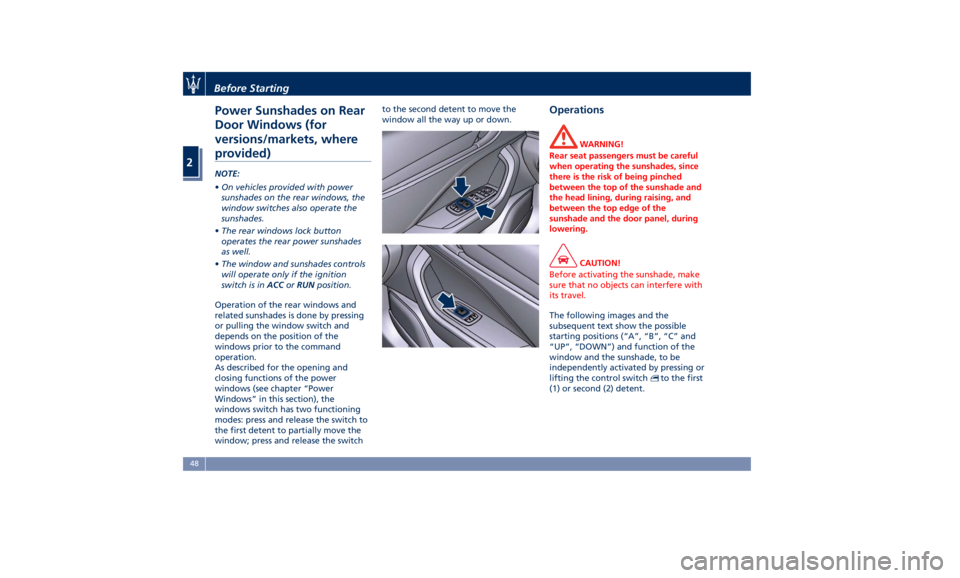
Power Sunshades on Rear
Door Windows (for
versions/markets, where
provided) NOTE:
• On vehicles provided with power
sunshades on the rear windows, the
window switches also operate the
sunshades.
• The rear windows lock button
operates the rear power sunshades
as well.
• The window and sunshades controls
will operate only if the ignition
switch is in ACC or RUN position.
Operation of the rear windows and
related sunshades is done by pressing
or pulling the window switch and
depends on the position of the
windows prior to the command
operation.
As described for the opening and
closing functions of the power
windows (see chapter “Power
Windows” in this section), the
windows switch has two functioning
modes: press and release the switch to
the first detent to partially move the
window; press and release the switch to the second detent to move the
window all the way up or down.
Operations WARNING!
Rear seat passengers must be careful
when operating the sunshades, since
there is the risk of being pinched
between the top of the sunshade and
the head lining, during raising, and
between the top edge of the
sunshade and the door panel, during
lowering.
CAUTION!
Before activating the sunshade, make
sure that no objects can interfere with
its travel.
The following images and the
subsequent
text show the
possible
starting positions (“A”, “B”, “C” and
“UP”, “DOWN”) and function of the
window and the sunshade, to be
independently activated by pressing or
lifting the control switch
to the first
(1) or second (2) detent.Before Starting
2
48